seats CHEVROLET KODIAK 2006 Owners Manual
[x] Cancel search | Manufacturer: CHEVROLET, Model Year: 2006, Model line: KODIAK, Model: CHEVROLET KODIAK 2006Pages: 398, PDF Size: 5.72 MB
Page 1 of 398
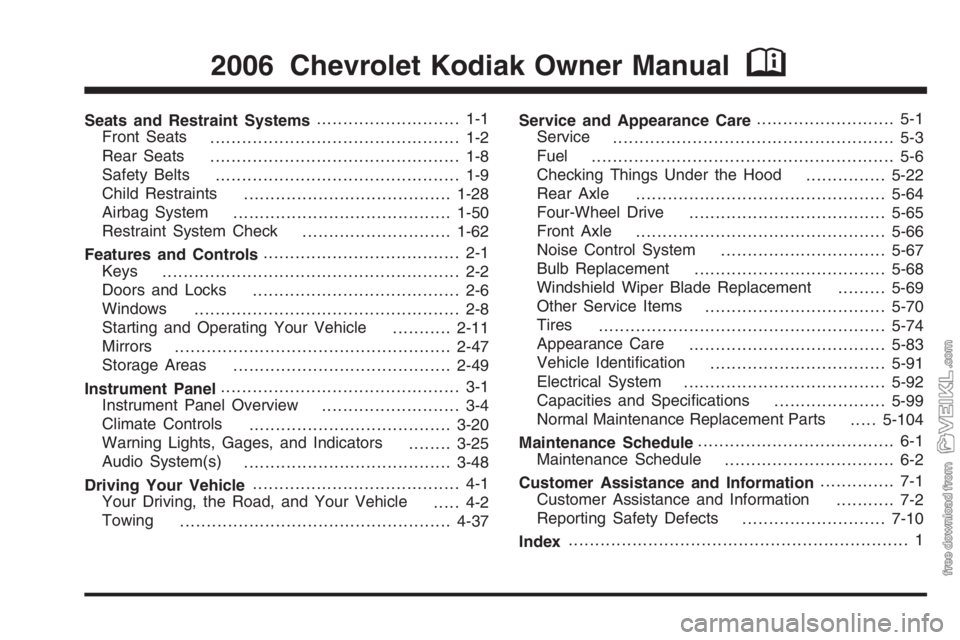
Seats and Restraint Systems........................... 1-1
Front Seats
............................................... 1-2
Rear Seats
............................................... 1-8
Safety Belts
.............................................. 1-9
Child Restraints
.......................................1-28
Airbag System
.........................................1-50
Restraint System Check
............................1-62
Features and Controls..................................... 2-1
Keys
........................................................ 2-2
Doors and Locks
....................................... 2-6
Windows
.................................................. 2-8
Starting and Operating Your Vehicle
...........2-11
Mirrors
....................................................2-47
Storage Areas
.........................................2-49
Instrument Panel............................................. 3-1
Instrument Panel Overview
.......................... 3-4
Climate Controls
......................................3-20
Warning Lights, Gages, and Indicators
........3-25
Audio System(s)
.......................................3-48
Driving Your Vehicle....................................... 4-1
Your Driving, the Road, and Your Vehicle
..... 4-2
Towing
...................................................4-37Service and Appearance Care.......................... 5-1
Service
..................................................... 5-3
Fuel
......................................................... 5-6
Checking Things Under the Hood
...............5-22
Rear Axle
...............................................5-64
Four-Wheel Drive
.....................................5-65
Front Axle
...............................................5-66
Noise Control System
...............................5-67
Bulb Replacement
....................................5-68
Windshield Wiper Blade Replacement
.........5-69
Other Service Items
..................................5-70
Tires
......................................................5-74
Appearance Care
.....................................5-83
Vehicle Identification
.................................5-91
Electrical System
......................................5-92
Capacities and Specifications
.....................5-99
Normal Maintenance Replacement Parts
.....5-104
Maintenance Schedule..................................... 6-1
Maintenance Schedule
................................ 6-2
Customer Assistance and Information.............. 7-1
Customer Assistance and Information
........... 7-2
Reporting Safety Defects
...........................7-10
Index................................................................ 1
2006 Chevrolet Kodiak Owner ManualM
Page 4 of 398
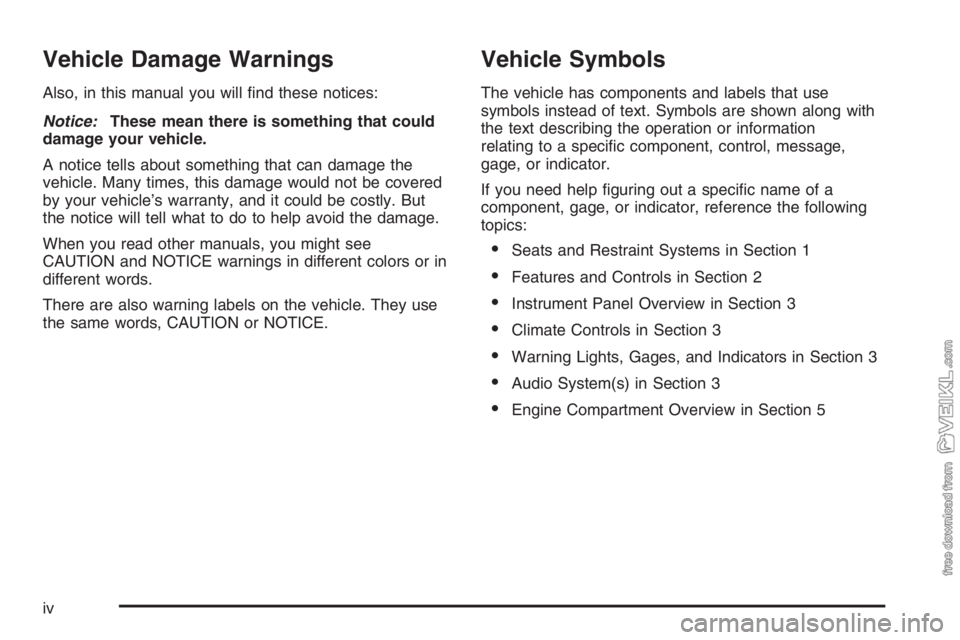
Vehicle Damage Warnings
Also, in this manual you will find these notices:
Notice:These mean there is something that could
damage your vehicle.
A notice tells about something that can damage the
vehicle. Many times, this damage would not be covered
by your vehicle’s warranty, and it could be costly. But
the notice will tell what to do to help avoid the damage.
When you read other manuals, you might see
CAUTION and NOTICE warnings in different colors or in
different words.
There are also warning labels on the vehicle. They use
the same words, CAUTION or NOTICE.
Vehicle Symbols
The vehicle has components and labels that use
symbols instead of text. Symbols are shown along with
the text describing the operation or information
relating to a specific component, control, message,
gage, or indicator.
If you need help figuring out a specific name of a
component, gage, or indicator, reference the following
topics:
•Seats and Restraint Systems in Section 1
•Features and Controls in Section 2
•Instrument Panel Overview in Section 3
•Climate Controls in Section 3
•Warning Lights, Gages, and Indicators in Section 3
•Audio System(s) in Section 3
•Engine Compartment Overview in Section 5
iv
Page 7 of 398
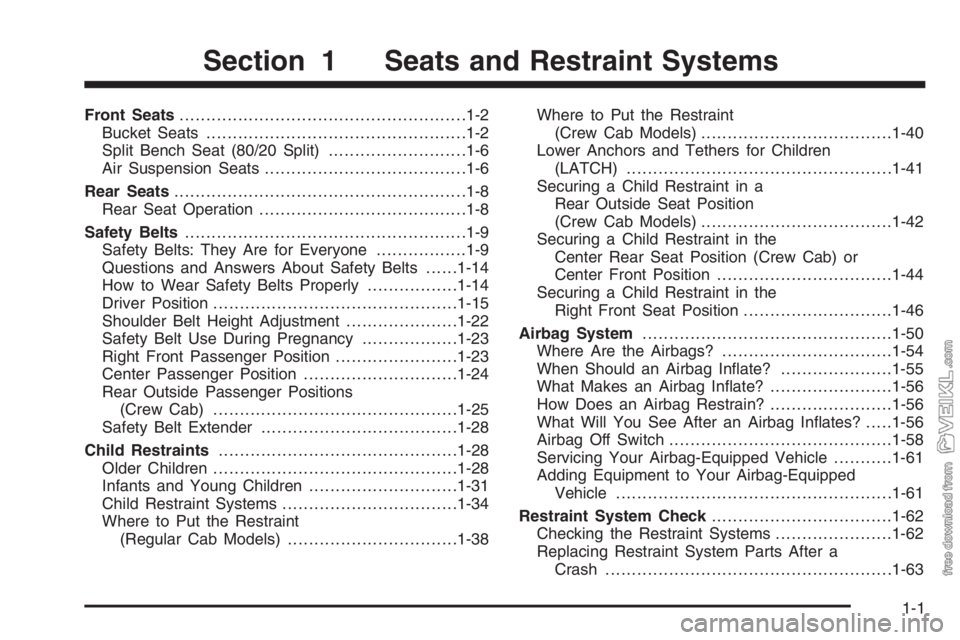
Front Seats......................................................1-2
Bucket Seats.................................................1-2
Split Bench Seat (80/20 Split)..........................1-6
Air Suspension Seats......................................1-6
Rear Seats.......................................................1-8
Rear Seat Operation.......................................1-8
Safety Belts.....................................................1-9
Safety Belts: They Are for Everyone.................1-9
Questions and Answers About Safety Belts......1-14
How to Wear Safety Belts Properly.................1-14
Driver Position..............................................1-15
Shoulder Belt Height Adjustment.....................1-22
Safety Belt Use During Pregnancy..................1-23
Right Front Passenger Position.......................1-23
Center Passenger Position.............................1-24
Rear Outside Passenger Positions
(Crew Cab) ..............................................1-25
Safety Belt Extender.....................................1-28
Child Restraints.............................................1-28
Older Children..............................................1-28
Infants and Young Children............................1-31
Child Restraint Systems.................................1-34
Where to Put the Restraint
(Regular Cab Models)................................1-38Where to Put the Restraint
(Crew Cab Models)....................................1-40
Lower Anchors and Tethers for Children
(LATCH)..................................................1-41
Securing a Child Restraint in a
Rear Outside Seat Position
(Crew Cab Models)....................................1-42
Securing a Child Restraint in the
Center Rear Seat Position (Crew Cab) or
Center Front Position.................................1-44
Securing a Child Restraint in the
Right Front Seat Position............................1-46
Airbag System...............................................1-50
Where Are the Airbags?................................1-54
When Should an Airbag Inflate?.....................1-55
What Makes an Airbag Inflate?.......................1-56
How Does an Airbag Restrain?.......................1-56
What Will You See After an Airbag Inflates?.....1-56
Airbag Off Switch..........................................1-58
Servicing Your Airbag-Equipped Vehicle...........1-61
Adding Equipment to Your Airbag-Equipped
Vehicle....................................................1-61
Restraint System Check..................................1-62
Checking the Restraint Systems......................1-62
Replacing Restraint System Parts After a
Crash......................................................1-63
Section 1 Seats and Restraint Systems
1-1
Page 8 of 398
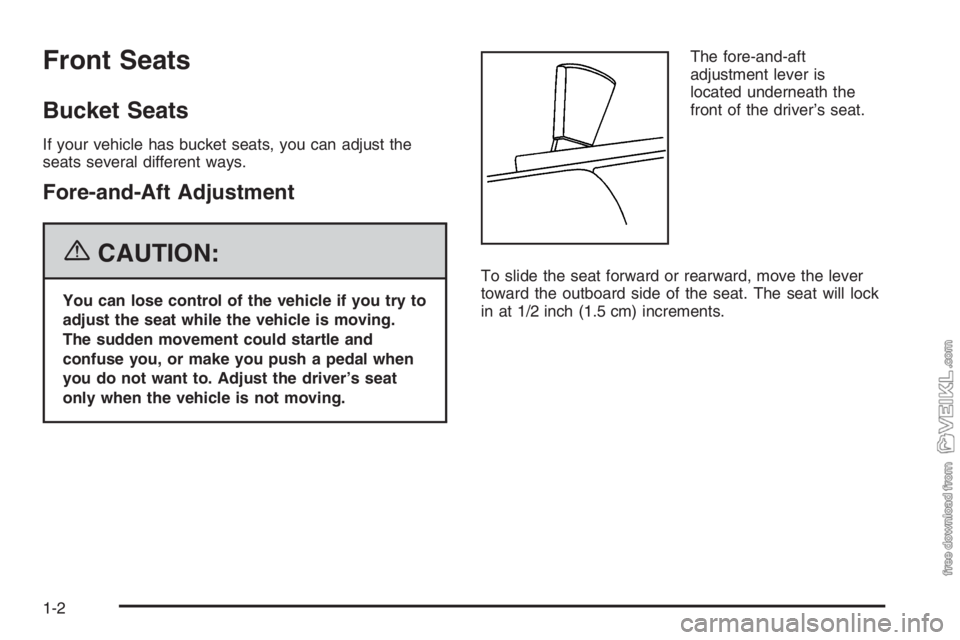
Front Seats
Bucket Seats
If your vehicle has bucket seats, you can adjust the
seats several different ways.
Fore-and-Aft Adjustment
{CAUTION:
You can lose control of the vehicle if you try to
adjust the seat while the vehicle is moving.
The sudden movement could startle and
confuse you, or make you push a pedal when
you do not want to. Adjust the driver’s seat
only when the vehicle is not moving.The fore-and-aft
adjustment lever is
located underneath the
front of the driver’s seat.
To slide the seat forward or rearward, move the lever
toward the outboard side of the seat. The seat will lock
in at 1/2 inch (1.5 cm) increments.
1-2
Page 9 of 398
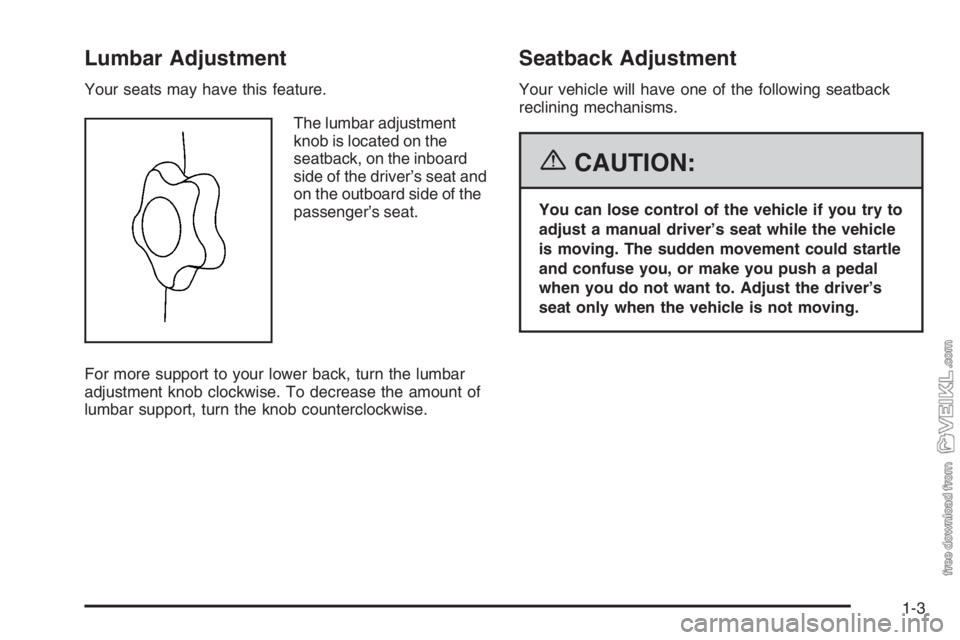
Lumbar Adjustment
Your seats may have this feature.
The lumbar adjustment
knob is located on the
seatback, on the inboard
side of the driver’s seat and
on the outboard side of the
passenger’s seat.
For more support to your lower back, turn the lumbar
adjustment knob clockwise. To decrease the amount of
lumbar support, turn the knob counterclockwise.
Seatback Adjustment
Your vehicle will have one of the following seatback
reclining mechanisms.
{CAUTION:
You can lose control of the vehicle if you try to
adjust a manual driver’s seat while the vehicle
is moving. The sudden movement could startle
and confuse you, or make you push a pedal
when you do not want to. Adjust the driver’s
seat only when the vehicle is not moving.
1-3
Page 12 of 398
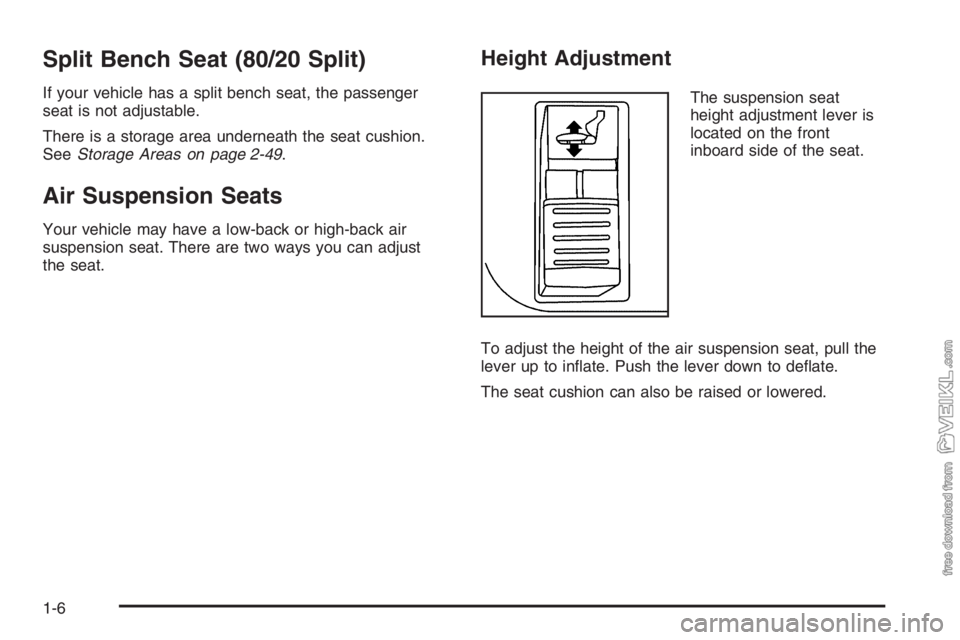
Split Bench Seat (80/20 Split)
If your vehicle has a split bench seat, the passenger
seat is not adjustable.
There is a storage area underneath the seat cushion.
SeeStorage Areas on page 2-49.
Air Suspension Seats
Your vehicle may have a low-back or high-back air
suspension seat. There are two ways you can adjust
the seat.
Height Adjustment
The suspension seat
height adjustment lever is
located on the front
inboard side of the seat.
To adjust the height of the air suspension seat, pull the
lever up to inflate. Push the lever down to deflate.
The seat cushion can also be raised or lowered.
1-6
Page 13 of 398
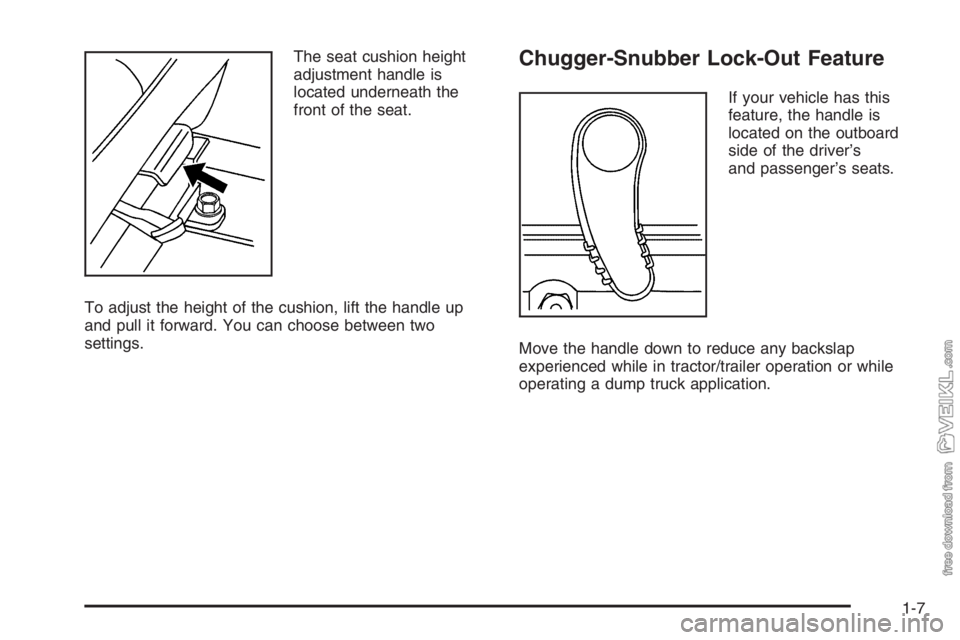
The seat cushion height
adjustment handle is
located underneath the
front of the seat.
To adjust the height of the cushion, lift the handle up
and pull it forward. You can choose between two
settings.Chugger-Snubber Lock-Out Feature
If your vehicle has this
feature, the handle is
located on the outboard
side of the driver’s
and passenger’s seats.
Move the handle down to reduce any backslap
experienced while in tractor/trailer operation or while
operating a dump truck application.
1-7
Page 14 of 398
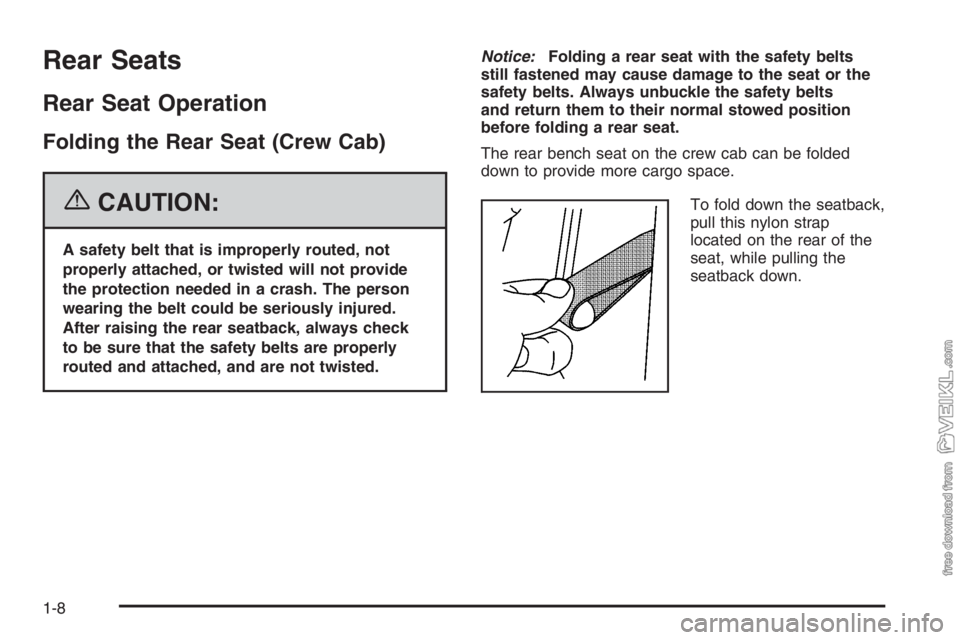
Rear Seats
Rear Seat Operation
Folding the Rear Seat (Crew Cab)
{CAUTION:
A safety belt that is improperly routed, not
properly attached, or twisted will not provide
the protection needed in a crash. The person
wearing the belt could be seriously injured.
After raising the rear seatback, always check
to be sure that the safety belts are properly
routed and attached, and are not twisted.Notice:Folding a rear seat with the safety belts
still fastened may cause damage to the seat or the
safety belts. Always unbuckle the safety belts
and return them to their normal stowed position
before folding a rear seat.
The rear bench seat on the crew cab can be folded
down to provide more cargo space.
To fold down the seatback,
pull this nylon strap
located on the rear of the
seat, while pulling the
seatback down.
1-8
Page 16 of 398
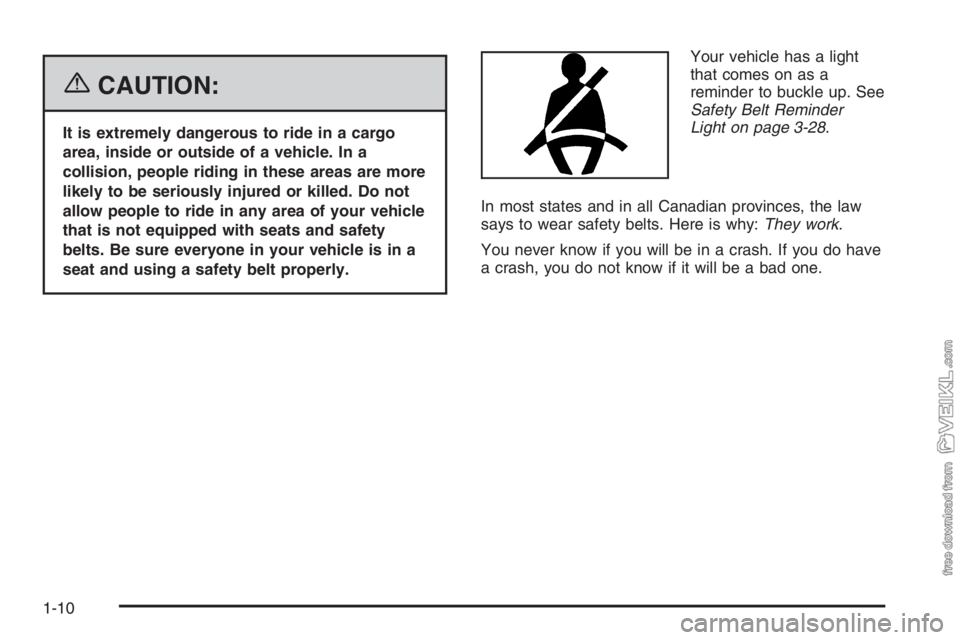
{CAUTION:
It is extremely dangerous to ride in a cargo
area, inside or outside of a vehicle. In a
collision, people riding in these areas are more
likely to be seriously injured or killed. Do not
allow people to ride in any area of your vehicle
that is not equipped with seats and safety
belts. Be sure everyone in your vehicle is in a
seat and using a safety belt properly.Your vehicle has a light
that comes on as a
reminder to buckle up. See
Safety Belt Reminder
Light on page 3-28.
In most states and in all Canadian provinces, the law
says to wear safety belts. Here is why:They work.
You never know if you will be in a crash. If you do have
a crash, you do not know if it will be a bad one.
1-10
Page 21 of 398
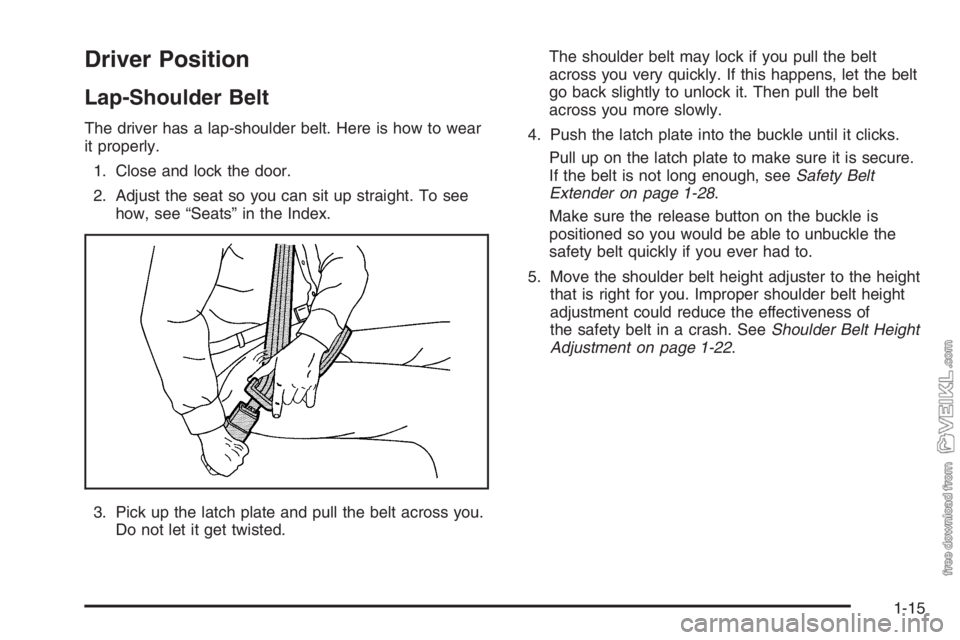
Driver Position
Lap-Shoulder Belt
The driver has a lap-shoulder belt. Here is how to wear
it properly.
1. Close and lock the door.
2. Adjust the seat so you can sit up straight. To see
how, see “Seats” in the Index.
3. Pick up the latch plate and pull the belt across you.
Do not let it get twisted.The shoulder belt may lock if you pull the belt
across you very quickly. If this happens, let the belt
go back slightly to unlock it. Then pull the belt
across you more slowly.
4. Push the latch plate into the buckle until it clicks.
Pull up on the latch plate to make sure it is secure.
If the belt is not long enough, seeSafety Belt
Extender on page 1-28.
Make sure the release button on the buckle is
positioned so you would be able to unbuckle the
safety belt quickly if you ever had to.
5. Move the shoulder belt height adjuster to the height
that is right for you. Improper shoulder belt height
adjustment could reduce the effectiveness of
the safety belt in a crash. SeeShoulder Belt Height
Adjustment on page 1-22.
1-15